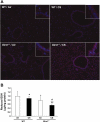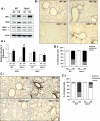Glutaredoxin 1 regulates cigarette smoke-mediated lung inflammation through differential modulation of I{kappa}B kinases in mice: impact on histone acetylation
- PMID: 20472709
- PMCID: PMC2928604
- DOI: 10.1152/ajplung.00426.2009
Glutaredoxin 1 regulates cigarette smoke-mediated lung inflammation through differential modulation of I{kappa}B kinases in mice: impact on histone acetylation
Abstract
Glutaredoxin 1 (Glrx1) is a small dithiol protein that regulates the cellular redox state and redox-dependent signaling pathways via modulation of protein glutathionylation. IkappaB kinase (IKK), an essential enzyme for NF-kappaB activation, can be subjected to S-glutathionylation leading to alteration of its activity. However, the role of Glrx1 in cigarette smoke (CS)-induced lung inflammation and chromatin modifications are not known. We hypothesized that Glrx1 regulates the CS-induced lung inflammation and chromatin modifications via differential regulation of IKKs by S-glutathionylation in mouse lung. Glrx1 knockout (KO) and wild-type (WT) mice were exposed to CS for 3 days and determined the role of Glrx1 in regulation of proinflammatory response in the lung. Neutrophil influx in bronchoalveolar lavage fluid and proinflammatory cytokine release in lung were increased in Glrx1 KO mice compared with WT mice exposed to CS, which was associated with augmented nuclear translocation of RelA/p65 and its phospho-acetylation. Interestingly, phosphorylated and total levels of IKKalpha, but not total and phosphorylated IKKbeta levels, were increased in lungs of Glrx1 KO mice compared with WT mice exposed to CS. Ablation of Glrx1 leads to increased CS-induced IKKbeta glutathionylation rendering it inactive, whereas IKKalpha was activated resulting in increased phospho-acetylation of histone H3 in mouse lung. Thus, targeted disruption of Glrx1 regulates the lung proinflammatory response via histone acetylation specifically by activation of IKKalpha in response to CS exposure. Overall, our study suggests that S-glutathionylation and phosphorylation of IKKalpha plays an important role in histone acetylation on proinflammatory gene promoters and NF-kappaB-mediated abnormal and sustained lung inflammation in pathogenesis of chronic inflammatory lung diseases.
Figures








Similar articles
-
Targeted disruption of NF-{kappa}B1 (p50) augments cigarette smoke-induced lung inflammation and emphysema in mice: a critical role of p50 in chromatin remodeling.Am J Physiol Lung Cell Mol Physiol. 2010 Feb;298(2):L197-209. doi: 10.1152/ajplung.00265.2009. Epub 2009 Dec 4. Am J Physiol Lung Cell Mol Physiol. 2010. PMID: 19965984 Free PMC article.
-
IKK alpha causes chromatin modification on pro-inflammatory genes by cigarette smoke in mouse lung.Am J Respir Cell Mol Biol. 2008 Jun;38(6):689-98. doi: 10.1165/rcmb.2007-0379OC. Epub 2008 Jan 31. Am J Respir Cell Mol Biol. 2008. PMID: 18239189 Free PMC article.
-
NF-κB inducing kinase, NIK mediates cigarette smoke/TNFα-induced histone acetylation and inflammation through differential activation of IKKs.PLoS One. 2011;6(8):e23488. doi: 10.1371/journal.pone.0023488. Epub 2011 Aug 24. PLoS One. 2011. PMID: 21887257 Free PMC article.
-
Regulation and function of IKK and IKK-related kinases.Sci STKE. 2006 Oct 17;2006(357):re13. doi: 10.1126/stke.3572006re13. Sci STKE. 2006. PMID: 17047224 Review.
-
Redox modulation of chromatin remodeling: impact on histone acetylation and deacetylation, NF-kappaB and pro-inflammatory gene expression.Biochem Pharmacol. 2004 Sep 15;68(6):1255-67. doi: 10.1016/j.bcp.2004.05.042. Biochem Pharmacol. 2004. PMID: 15313424 Review.
Cited by
-
PEP-1-GLRX1 protein exhibits anti-inflammatory effects by inhibiting the activation of MAPK and NF-κB pathways in Raw 264.7 cells.BMB Rep. 2020 Feb;53(2):106-111. doi: 10.5483/BMBRep.2020.53.2.180. BMB Rep. 2020. PMID: 31964467 Free PMC article.
-
Pharmacological antioxidant strategies as therapeutic interventions for COPD.Biochim Biophys Acta. 2012 May;1822(5):714-28. doi: 10.1016/j.bbadis.2011.11.004. Epub 2011 Nov 9. Biochim Biophys Acta. 2012. PMID: 22101076 Free PMC article. Review.
-
Oxidative stress and chromatin remodeling in chronic obstructive pulmonary disease and smoking-related diseases.Antioxid Redox Signal. 2013 May 20;18(15):1956-71. doi: 10.1089/ars.2012.4863. Epub 2012 Nov 6. Antioxid Redox Signal. 2013. PMID: 22978694 Free PMC article. Review.
-
Glutathione redox control of asthma: from molecular mechanisms to therapeutic opportunities.Antioxid Redox Signal. 2012 Jul 15;17(2):375-408. doi: 10.1089/ars.2011.4198. Epub 2012 Mar 9. Antioxid Redox Signal. 2012. PMID: 22304503 Free PMC article. Review.
-
Mitogen- and stress-activated kinase 1 (MSK1) regulates cigarette smoke-induced histone modifications on NF-κB-dependent genes.PLoS One. 2012;7(2):e31378. doi: 10.1371/journal.pone.0031378. Epub 2012 Feb 1. PLoS One. 2012. PMID: 22312446 Free PMC article.
References
Publication types
MeSH terms
Substances
Grants and funding
LinkOut - more resources
Full Text Sources
Other Literature Sources
Molecular Biology Databases
Research Materials

